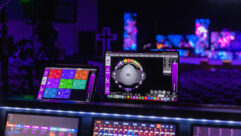GETTING NOTICED
May 1, 1999 12:00 PM,
Paul Gulick
As digital display technology develops and advances, new marketapplications emerge. To date, most of these applications have fallen in therealm of business presentations. Now, presentation technology-with itsability to present large, bright, compelling, moving images-is ready toenter and change the signage market. Soon, dynamic digital signage willappear across the retail landscape and in public areas. Consequently,marketers will gain greater control over time-critical messages and contentat lower cost and make real-time changes instead of waiting weeks or monthsfor rollout of standard print signage; they will have be able to provideconsumers with information tailored to specific needs or circumstances,rather than the one-size-fits-all nature of static signage.
This signage is called dynamic because of the realism and movement itoffers. Consumers can see the steam rising off coffee, the bubbles poppingin a soda, the texture and swing of a fabric as its wearer moves. Thesesigns are also dynamic because they can be changed often, easily,inexpensively and in real time, that is to say, immediately. Any availabledigital assets or resources can be used and appear, system-wide, at thepoint of sale. These changes can be made frequently; they can furnish menurotation for every mealtime shift, cater to differences between daytime andevening retail shoppers or feature fast-breaking promotions. Finally, thissignage is dynamic because it can enable the movement of images andmessages throughout a system to many installations across the country oraround the world. From one location, a marketing manager can launch orrevise a campaign that appears on every sign throughout a given system viatelecommunications-Internet or Intranet, LAN or WAN.
In addition to compelling realism, quickly changeable content andgeographic reach, dynamic signage gives the manager control over theconsistency of the corporate brand and message across all markets. Thereare also substantial savings in both cost and time when compared todesigning, manufacturing, distributing and installing duratranspanels,cardboard cutouts or other traditional signage formats. Moreover, dynamicsignage dispenses with clutter.
It is important to note that dynamic signage in its ultimate application isnot exactly the same as a kiosk. The typical kiosk, through interactionwith a user, provides information on demand from such sources as a databaseor even the Internet. Consequently, there must be some device-either akeyboard or a touchscreen-that facilitates this interaction. Often seenexternally as a simple box with a monitor, kiosks find application inmuseums, retail stores, airports and other place in which people may havethe time to stop and deliberately query information.
Dynamic signage hovers somewhere between television and informationalkiosks. There are times when offering interaction becomes unnecessary oreven wasteful. When standing in line to make a purchase, a customer isunlikely to leave his place to use a kiosk. An element of dynamic signage,however, provides information without direct interaction, information thatmay be already tailored to mesh with the needs of a certain type ofconsumer.
Where it worksDynamic signage holds the most promise for those market segments that dealwith continually changing information-interest rates, rotating meal menus,seasonal wardrobe changes or one-day sales. Banks, quick-servicerestaurants and department stores will be among the early adopters ofdynamic signage. Because LCD displays, technology commonly used in thissignage, are relatively thin profile and lightweight, they can bepositioned at the consumer’s point of decision. That may be at the ordercounter of a fast food restaurant, along a supermarket aisle or amongdepartment store racks.
There is also a market segment involving public areas. On the one hand,this would include supermarkets, malls and cinema complexes. In thesecases, either the chain or a media company can sell advertising space to anumber of buyers. Potential advertisers, in some instances, are alreadypaying for floor space and slotting fees. Revenue gathered from advertiserswho want to influence buyers’ decisions represents a new source of profitat this market point. Similarly, airports, mass-transit stations and largeathletic, entertainment or other public assembly venues offer marketpotential. Backlit panels are common to these applications, but dynamicsignage could also be effective.
Just how effective and compelling is dynamic signage? From a number oftests, results from a specialty retailer show that when compared withstatic signage, dynamic signage installations get 10x the eye contact; thatis, 10x more people look at and pay attention to dynamic signage. In exitinterviews, of the people who recall seeing a message, 2.5x more peoplerecall the content or the purpose of the dynamic message. In QSR testing,preliminary data support a 3% to 5% sales increase in the stores that havedynamic signage when compared to other stores in the same geographicregion. When a new product is introduced, dynamic signage contributes to a25% increase in sales of that product.
Means of operationDynamic signage consists of several components. First, there is thecontent, essentially any digital content that can be routed through acomputer-video or desktop multimedia. Also, the hardware and software drivethe content through the system, update it, automatically schedule it,ensure continuous up-time and allow the right mix of local control; thesystems integrator or service provider assembles the pieces and offers apackage solution. Finally, there is the display itself, the interface withthe target audience, the link to the customer that makes dynamic signagecome to life.
Display elements themselves are available in a variety of media, includingLCD, plasma, DLP and even the standard CRT monitor. LCD units are availableas large-screen digital units in a range of formats, among them 40 inch (1m) and 52 inch (1.3 m) diagonal displays. Units can be as thin as 18 inches(457 mm) and as light as 90 pounds (40.5 kg) with the brightness necessaryfor high ambient light conditions in retail environments. Such units asthose available from Clarity Visual Systems can accept a range of signalinputs-SVGA, VGA, MacII and progressive scan video are standard. Speciallydeveloped black-stripe screens give wide viewing angles and optimumcontrast while absorbing glare caused by reflective light. The modules canbe used singly, arrayed horizontally in banners, vertically in posts or inboth dimensions as videowalls.
Gas plasma technology, although more expensive than LCD, provides its ownset of advantages. Plasma displays are essentially an array of pixels, eachof which contains three subpixels corresponding to red, green and blue. Gasis excited to a plasma state by an address electrode and reacts withphosphors in each individually controlled subpixel capable of producing16.7 million colors. Consequently, plasma displays can be thinner than 6inches (152 mm) and have a completely flat surface. The net result is abright, high-resolution display device with wide viewing angles that caneven be placed in walls. The devices, because of the physics behind theiroperation, are immune to magnetic interference, and their 16:9 aspect ratiofosters HDTV compatibility.
There are technical issues. To operate effectively, the display system mustbe designed from the ground up as a dynamic sign. A number of LCDrear-projection displays designed to fit the varying requirements ofdifferent retail and public environments are currently available. Overtime, LCD projection will get thinner and cost less. Consequently, it willcontinue to be the technology of choice for dynamic signage in the future,but other options, namely plasma, are viable as well.
A new marketThe real factors driving innovation in this market are the proliferation ofinformation in our daily lives and the ability to convert that informationinto digital form. Advertisers demand compelling ways to provideinformation to consumers when those consumers are making purchasedecisions. There is demand, too, on the part of the customers. Now thatpeople are accustomed to seeing this digital content in other areas oftheir lives-homes, schools or offices, wherever their browser is-it isnatural to see it in retail locations. Consumers have come to expectinformation to be delivered where they can use it-again, at the point ofdecision.
At this point, the only factor slowing adoption of dynamic signage istime-time for retailers to understand the concept, time for them tovalidate its use in their own environments in light of the data gatheredfrom other stores that demonstrate its effectiveness. Clarity, for example,undertakes testing with new major retailers to demonstrate the power ofdynamic signage, and it will take a couple of years to cross the chasm.Dynamic signage will soon show up in many opportunity-oriented retailspaces, and as it gains acceptance, there is no reason why systemsintegrators should not take advantage of this market growth.
The promise that dynamic signage offers is this: As customers and consumerstravel from one retail space to another, they will no longer be inundatedwith clutter and conflicting messages. In today’s supermarket, mall andfast food environments, we see many huge, blaring, brightly colored signsshowing everything or, at the least, the most common denominator.Ultimately, this is not helpful. Dynamic signage can actually helpeliminate this clutter by offering a single point of display for multiplemessages. It can respond to the specific needs of the individual customerand assist his buying decision in a clear, concise, informative way.
Imagine that, as you enter a mall or other retail or entertainmentenvironment, you swipe your loyalty card. Embedded in that card are yourpreferences and other specific information. As you walk through theenvironment, signage displays provide information that you are interestedin. By being completely digital and complexly dynamic, retail can adapt itsgrowing storehouse of information to what each of its customers wants. Itsounds far-fetched today, but when retailers make the investment in alarge-screen digital display and the computer system to drive it, manythings become possible. These retailers position themselves well for anynumber of future innovations. By familiarizing yourself with thistechnology, you should, in turn, be able to offer existing clients a newmeans expression, and equally important, you may develop prospects inpreviously ignored and completely new markets.










